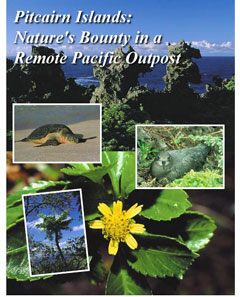 |
Pitcairn Islands
Nature's Bounty in a Remote Pacific Outpost
Pitcairn Island is best known as the haven for the mutineers from HMS Bounty over 200 years ago. This group of four small, varied South Pacific islands range from Pitcairn itself (4.5km2) to Henderson Island - a 37km2 raised coral atoll and the largest island - and low-lying coral atolls of Oeno and Ducie. The nearest land masses are over 4,500km away, New Zealand to WSW and South America to the east. Only Pitcairn is inhabited; the small community of less than 50 lives at Adamstown, isolated by more than a day’s sail from its nearest neighbours in French Polynesia, around 500km NW.
Pitcairn biodiversity and conservation needs have become better known in recent years following a major scientific expedition in 1991-92. The indigenous vegetation of Pitcairn Island is confined to small, isolated patches. Now that a small nursery has been established on Pitcairn, sustained restoration effort is needed to safeguard these remnants and the endemic plants they support.
The other islands support a range of endemic plants and animals. The ‘chicken bird’ (a jet black, flightless rail confined to Henderson Island - a World Heritage Site) seems to be less vulnerable to predation by rats than are the petrels. Of special concern is the recently described Henderson petrel.
Darwin Initiative and other UK funds have helped develop local conservation skills and support a successful rat eradication programme on Oeno and Ducie in the 1990s. From 2011, a major exercise is attempting to eradicate rats on Henderson.
The Pitcairn Natural Resources Departmentis working to ensure that sustainable development proceeds alongside environmental protection and conservation of local natural resources using the Pitcairn Environment Management Plan as a framework.
about Virtual Tours....
|
 |
|












